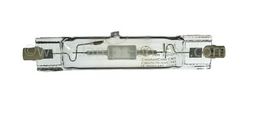Introduction
Low Wattage Metal Halide lamps where developed in the late 1980’s to provide a solution for small area floodlighting. The first made wheredouble ended HQI-TS , and then single ended HQI T lamps followed for use in downlights in retail environments to provide more light from a given area, more “punch”. Light fixture manufacturers such as connect Lighting, Sill and Reggiani were the first manufacturers to adopt these light sources and develop fittings to incorporate Metal Halide lamps. The market leader was Osram and its sister company Wotan Lamps with their HQI-T and HQI-TS lamps. Other lamp manufacturers soon followed suit , BLV with HIT and HIT-DE , Philips with MHN-T and MHN-TD, Sylvania with HSI-T and HSI-TD and GE with their Arcstream range.
In 1994 Philips Lighting developed a successor to the HQI-TS low wattage metal halide lamp, the low wattage metal halide ceramic lamp CDM-T and CDM-TD that used a ceramic arc tube instead of a quartz arc tube. They became an instant success.
Technical Details
The arc tube (the bubble in the middle of the lamp) in a CDM-T or CDM-TD lamp is made of a ceramic compound whereas in an HQI-T or HQI-TS its made of quartz.
Quartz lamps can be prone to Sodium migration, this is where sodium atoms work their way outside the quartz arc tube causing a depletion of sodium. The result of this is a shift in colour temperature or inconsistencies in the colour of lamps.Ceramic has a much smaller molecular structure which means that the sodium atoms are unable to pass to the outer wall of the arc tube. The sodium stays inside the arc tube and the colour is consistent during the life of thelamp. A way to look at this is if you imagine that quartz atoms are the size of a beach ball and sodium atoms are the size of a pea, if you built a wall using beach balls the pea would be able to pass through the gaps between the balls, this is how sodium migration occurs. For ceramic CDM-T it would have an atomic size similar to sand, so if you built a wall using sand (OK it needs a little imagination) the pea (sodium) would not be able to pass through as there would not be any gaps between the sand particle big enough , the sodium burns yellow inside the arc tube and colour stability is maintained.
Summary
Ceramic CDM-T lamps are a better option than Metal Halide HQI-TS lamps due to their improved colour stability and lumen maintenance. These are the reasons that you will now see many more low wattage CDM-T metal halide ceramic lamps than HQI-TS quartz equivalents in retail and industrial environments.



